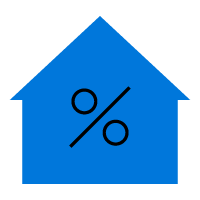Across the United States, it seems like rents are higher than ever.
If you’re wondering why rent is so expensive these days, there’s no single, definitive answer. Instead, we see a lot of factors are contributing to historically high rents and rapid increases. According to the Bureau of Labor Statistics’ Consumer Price Index, the cost of rent for primary residences in the U.S. rose by 6.3% from July 2021 to July 2022 — the highest year-over-year increase since the period of January 1985 to January 1986.
Reasons why rent is so high range from general inflation to fewer housing units being constructed in recent years to plain, old high demand for housing — and much more.
Read on for a closer look at why rent is so expensive in the U.S.
Credit Karma Stat Snapshot

Year-over-year inflation rates have reached levels not seen since 1980 to 1981
Year-over-year inflation rates for rent of primary residences have increased every single month from the previous month in 2022
Costs that landlords often pass on to renters have seen historically high inflation rates in 2022 as well

Construction of renter-occupied housing units has not kept pace with demand over the years
Overview of why rent is so high
Many factors help explain why rent is so high and continuing to rise. Some of those factors involve more short-term issues, while other issues are longer term.
Higher inflation overall and for housing-related items and services
Overall inflation and sector-specific inflation may naturally contribute to expensive rent. News commentators and economists have been stressing how high year-over-year inflation rates have gotten in 2022, and with good reason.
From June 2021 to June 2022, the year-over-year inflation rate for all items was 9%, the highest rate of year-over-year inflation since November 1980 to November 1981, when it was 9.6%. Equally important is the high rate of inflation for specific items and services in 2022. The inflation rate of rents, housing fuel and utilities, home appliances and household repairs, among other things, have all reached historic heights in 2022. All of this, both directly and indirectly, could contribute to why rent is so expensive.
Less new home construction
One longer-term factor is the severe decline in new home construction for a decade after the housing market crash in the early 2000s. The reduction in new available housing has resulted in reduced supply of available homes to both buy and rent. This dip in supply is likely one of the most significant factors contributing to the seemingly relentless rise in rental prices.
Higher demand for rentals
Census Bureau data indicates that more people have been moving into rental situations versus owning their own homes, creating higher demand for rentals. While 15.7 million householders moved into an owner-occupied housing unit in 2015 or later, more than 24.9 million householders moved into a renter-occupied housing unit during that time.
High overall inflation rates
The U.S. is experiencing historically high inflation rates. And the country’s unsettlingly high general inflation rate year-over-year from 2021 to 2022 is contributing to higher prices and costs across the board. But just how bad is inflation currently compared to other periods in our history?
According to the latest Bureau of Labor Statistics data, the year-over-year inflation rate for all items in the U.S. was 8.5% for the period July 2021 to July 2022.
That’s down from 9% for June 2021 to June 2022 — but 8.5% still ranks among the highest rates of inflation going back 40 years.
Month-to-month inflation rates aren’t good either. In 2022, from February to March, the inflation rate for all items was 1.24% and from May to June it was 1.32%. By contrast, in 2021, every single month-to-month inflation rate was below 1%.
This table breaks down the year-over-year inflation rates (for all items) — month by month for 12 months between August 2020 and July 2022.
Year-over-year inflation rates: August 2020–July 2022
| Period range | Year-over-year inflation rate |
| August 2020–August 2021 | 5.2% |
| September 2020–2021 | 5.4% |
| October 2020–2021 | 6.2% |
| November 2020–2021 | 6.8% |
| December 2020–2021 | 7.1% |
| January 2021–2022 | 7.5% |
| February 2021– 2022 | 7.9% |
| March 2021–2022 | 8.6% |
| April 2021–2022 | 8.2% |
| May 2021–2022 | 8.5% |
| June 2021–2022 | 9.0% |
| July 2021–2022 | 8.5% |
The table shows that despite all the recent talk of high inflation, it’s not exactly news. We’ve been seeing rising year-over-year inflation rates pretty consistently since mid-2021.
While the annual average inflation rate for 2019 to 2020 was 1.3%, in the first month of 2021, year-over-year inflation already exceeded that figure, with the inflation rate from January 2020 to January 2021 being 1.4%.
A high rate of inflation for all items in the U.S. naturally reflects rising prices across all sorts of sectors, services and goods — including rent. But to get a clearer picture of high inflation’s effect on the cost of rent, it helps to look at the inflation rates of individual, specific elements of everyday life.
High inflation rates for housing and rent overall
The housing category of BLS’s consumer price index showed a year-over-year inflation rate of 7.4% for July 2021 to July 2022. That’s the highest year-over-year inflation rate for housing for any month in 2022 thus far.
But this data point isn’t just about rent, although that’s included. Dozens of factors from household insurance to energy costs to gardening and lawncare services also figure into the consumer price index for housing.
Because the BLS housing category is so broad, it might be even more enlightening to zero in on the inflation rates of some of those specific factors — beginning with just rent itself.
This table gives a detailed breakdown of the inflation rates of rent in America, comparing the growth between 2020 and 2021 to the growth between 2021 and 2022 across the same months.
Rent inflation: 2020 vs. 2021 and 2021 vs. 2022
| Month | 2020 vs. 2021 inflation rate for rent | 2021 vs. 2022 inflation rate for rent |
| January | 2.1% | 3.8% |
| February | 2.0% | 4.2% |
| March | 1.8% | 4.4% |
| April | 1.8% | 4.8% |
| May | 1.8% | 5.2% |
| June | 1.9% | 5.8% |
| July | 1.9% | 6.3% |
| August | 2.1% | – |
| September | 2.4% | – |
| October | 2.7% | – |
| November | 3.0% | – |
| December | 3.3% | – |
For much of 2021, the year-over-year inflation rate of rent costs were comparatively low, bottoming out at approximately 1.8% from March through May.
Then, however, the rent inflation rate began to steadily rise, starting with 2.1% from August 2020 to August 2021, and reaching 3.3% for the period December 2020 to December 2021. By the start of 2022, the year-over-year inflation rate of rent was on a nonstop climb, going from 3.8% for January 2021 to January 2022 to 6.3% for July 2021 to July 2022.
The month-to-month inflation rate for rent costs is also remarkable. While in 2021 the highest month-to-month inflation increase rate was 0.4%, in 2022 the inflation increase rate for rent reached a lofty 0.8% from May to June 2022.
High inflation rates for rent-related costs
Another way to explain rising rents is to view the issue from the perspective of landlords. It’s not uncommon for landlords to pass their costs onto their tenants — so when things like repairs, appliances and maintenance get more expensive, it makes sense that rents would go up.
Household appliances
The consumer price index for household appliances saw huge increases in costs. Though there’s only data for January through July 2022, the annual average year-over-year inflation rate for household appliances is 7.1%. That’s the highest annual inflation rate since the data series inception in 1999.
Household fuel and utilities
Although utilities are often excluded from the cost of monthly rent, some lease contracts do include household fuel and utilities like electricity, gas service, water and sewage.
An increase in prices for these services might have an impact on the cost of rent — and the year-over-year inflation rates for household fuel and utilities in 2022 are staggering. In the period January 2021 to January 2022, the inflation rate reached 11.9%, the highest inflation rate year-over-year since it reached 12.2% for the period September 2007 to September 2008.
In February 2022, the year-over-year inflation rate briefly declined, only for it to roar back in the following months. By June 2022, the price of household fuel and utilities had risen by 17.7% from June 2021. That year-over-year surge is the largest since January 2005 to January 2006, when the inflation rate was 19%.
Reduced construction of rental units
Beyond high inflation, the supply of rental housing units is a longer-term factor that might contribute to higher rent. New construction of housing units declined quite a bit after the housing market began to contract in 2006, preceding the 2008 financial crisis.
Data from the Census Bureau’s 2020 American Community Survey reveal a decrease in the construction of new housing units.
Decline in total new housing units
The percentage of total occupied housing units that were built from 2000 to 2009 was 13.8%. But for the years 2010 and later, the percentage of occupied housing units built had fallen to only 6.3%, less than half the amount constructed in the previous period.
That equates to the construction of 16.9 million occupied housing units in 2000 to 2009 versus the construction of only 7.6 million units in 2010 and later.
Decline in new renter-occupied housing units
The construction of new renter-occupied housing units shows a similar decline in building new housing after the housing crash.
Out of the approximately 122.3 million total occupied housing units in 2020, approximately 43.6 million of them were renter-occupied housing units. That equates to renter-occupied units making up 35.6% of total occupied housing units, which is down from 36.1% in 2015.
From 2000 to 2009, more than 4.6 million renter-occupied housing units were constructed. But from 2010 onward, only roughly 2.9 million renter-occupied units were built.
While renter-occupied units built between 2000 and 2009 represented 10.7% of all renter-occupied units in 2020, those built from 2010 onward represent only 6.7%.
Fewer units could lead to a reduction in supply, triggering an increase in rent prices.
Change in the composition of rental housing
Another telling data point: the composition of renter-occupied housing units — meaning the type of units that renters are occupying.
Trend toward studio rentals vs. one-bedrooms
In 2015, 1.98 million renter-occupied housing units had no bedroom, commonly known as studios. By 2020, that number had risen to 2.5 million renter-occupied housing units with no bedrooms. That’s equivalent to a 25.5% increase in renter-occupied housing units without bedrooms from 2015 to 2020.
While this may not be a factor in why rent is so expensive, it may be a reflection of increasing demand for lower-cost rental units. Studios tend to be cheaper than one-bedroom apartments.
Trend toward renting vs. owning
An additional development that’s putting upward pressure on the cost of rent is the increase in people flocking to rental units as opposed to owner-occupied units. The upshot: More people have been moving into rental situations versus owning their own homes.
According to Census Bureau data, more than 15.7 million householders moved into an owner-occupied housing unit in 2015 or later, which equates to 20% of owner-occupied housing units having householders who moved in from 2015 onward. By contrast, more than 24.9 million householders moved into a renter-occupied housing unit in 2015 or later, which equates to 57.3% of renter-occupied units having householders who moved in from 2015 onward.
When looking at total occupied housing units — both owner-occupied and renter-occupied — the trend is similar. Out of more than 122.3 million total occupied housing units in 2020, 12.9% of householders moved into owner-occupied homes in 2015 or later. By comparison, 20.4% of householders moved into renter-occupied homes in 2015 or later.
The faster growth in renters compared to owners occupying households is yet another factor contributing to the rise in rents across the country.
What you can do when rent is so expensive
Create a budget
Consider establishing a monthly budget and start tracking your spending. The 50/30/20 rule budget is one way to manage your money that doesn’t require creating overly complex budgeting categories. Instead, you aim to spend 50% of your after-tax pay on necessities, 30% on wants, and 20% on savings or paying off debt.
Pay down your credit card balances
There are a number of ways to tackle credit card debt that can help you get your balances to zero. You can either pay off each debt separately or consolidate your debts into a single monthly payment.
You might want to create a repayment plan by implementing either the debt snowball method or debt avalanche method.
The debt snowball method takes aim at your smallest debt first. You’ll need to keep up with the minimum monthly payments on all your other debts, then put any extra money you have toward paying off the smallest debt. As each debt is paid off, the money that was used for the previous debt is “snowballed” and used to pay the next smallest debt. You can keep repeating this process until all debts are paid off.
The debt avalanche method aims to pay off the debt with the highest interest rate first, while keeping up with the minimum monthly payments on all your other debts. After eliminating the first debt, you can move on to the debt with the second-highest interest rate — repeating the process until all debts are paid off.
Cancel unnecessary subscriptions
The small monthly fees you pay for subscriptions — which may include gaming apps as well as music- and video-streaming apps — can really add up. Take some time to go through your bank account or credit card statements to target monthly subscription charges that aren’t worth the continued expense.
Start an emergency fund
An emergency fund is a savings account where you can store cash to help get yourself through a financial crisis — like the loss of your job. You should try to have enough in your emergency fund to cover three to six months’ worth of expenses if you’re out of work, but this could vary based on your personal situation. If you think it might take longer to find another job or you have a lot of people depending on you, consider saving more. If you put away a small amount each paycheck, you can work steadily to reach your goal.
Rent vs. buy calculator
Find out if it makes more financial sense for you to buy a home or rent one with our rent vs. buy calculator.
Methodology
This study isn’t meant to be a definitive answer to the question of why rent is so expensive. Rather, it’s an exploration of various short- and longer-term factors potentially contributing to rising and expensive rents across the U.S.
This study examines the U.S. as a whole, along with major cities with populations of 100,000 or more. The following were the primary study criteria:
- Population growth, from 2015 to 2020, sourced from the Census Bureau’s 2020 and 2015 American Community Survey, 5-Year Estimates
- Occupied housing units, owner-occupied housing units, and renter-occupied housing units, in absolute numbers and percentage of total occupied housing units, as well as the change from 2015 to 2020, sourced from the Census Bureau’s 2020 and 2015 American Community Survey, 5-Year Estimates
- Percentage and absolute numbers of renter-occupied housing unit types, including 1) single detached unit, 2) single attached unit, 3) two apartments, 4) three to four apartments, 5) five to nine apartments, 6) 10 or more apartments; and their change over time, from 2015 to 2020, sourced from the Census Bureau’s 2020 and 2015 American Community Survey, 5-Year Estimates
- Percentage and absolute numbers of tenure by year householder moved into occupied housing units, owner-occupied housing units, and renter-occupied housing units, sourced from the Census Bureau’s 2020 American Community Survey
- Percentage and absolute numbers of renter-occupied housing units with no bedroom and change over time, sourced from the Census Bureau’s 2020 and 2015 American Community Survey, 5-Year Estimates
- Monthly rent for July 2017, 2018, 2019, 2020, 2021, 2022, including the one-year change in rent, five-year change in rent, and average annual change in monthly rent over five years, from 2017 to 2022, sourced from Apartment List and Zillow (depending on availability of data for cities).
- Housing units built, in absolute numbers and as a percentage of total housing units, by the year the housing units were built: 1) built 2010 or later, 2) built 2000 to 2009, 3) built 1990 to 1999, 4) built 1980 to 1989, 5) built 1970 to 1979, 6) built 1960 to 1969, 7) built 1950 to 1959, 8) built 1940 to 1949, 9) built 1939 or earlier, sourced from the Census Bureau’s 2020 and 2015 American Community Survey, 5-Year Estimates
Sources
- Census Bureau American Community Survey 2020, 5-Year Estimates: B25034 – Year Structure Built
- Census Bureau American Community Survey 2020, 5-Year Estimates: S2504 – Physical Housing Characteristics for Occupied Housing Units
- Census Bureau American Community Survey 2015, 5-Year Estimates: S2504 – Physical Housing Characteristics for Occupied Housing Units
- Apartment List
- Zillow
- Census Bureau American Community Survey 2020, 5-Year Estimates: B01003 – Total Population
- Census Bureau American Community Survey 2020, 5-Year Estimates: B25129 – Tenure by Year Householder Moved into Unit by Units in Structure
- Bureau of Labor Statistics’ Consumer Price Index



